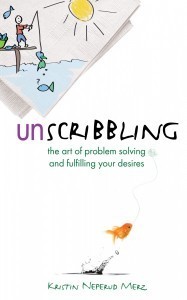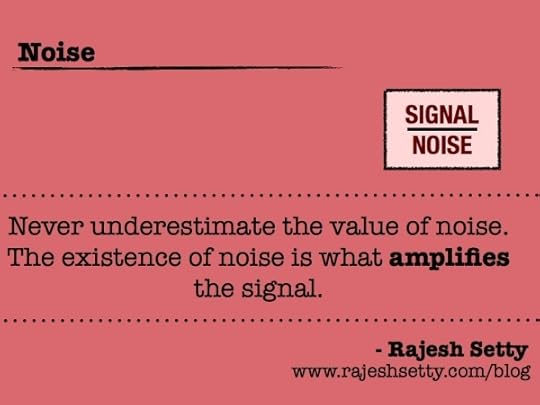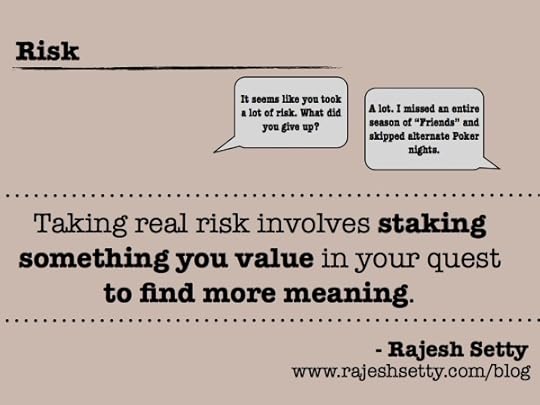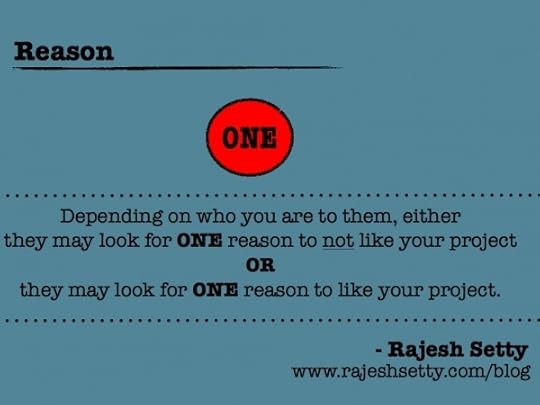Rajesh Setty's Blog, page 12
September 8, 2012
How to be Remarkable
You and I both know that one cannot become remarkable overnight. We also know that being remarkable has many benefits – the biggest one is that you have a better opportunity to make a bigger difference in this world.
So, how do you get started?
How do you take a proactive approach to become remarkable?
During my consulting engagements at Foresight Plus, I get to see many smart people transforming themselves to be remarkable people. It’s a joy to watch and a privilege to be part of that process.
Here is the approach that has worked time and again.
1. Identify one or two of your core skills:
Find out one or a maximum of two skills that you are extremely good at. How do you know you are good at them? Not by you thinking that you are good at them but the results you produce when you are using those skills. Results you produce will have a final say in this matter.
Let’s suppose that the two skills are marketing and storytelling.
2. Understand where someone is going:
Take someone in your network and really understand where they are going – their hopes and dreams. This is easier said than done. You need to be REALLY listening to what they are saying and watching where they invest their time and energy to understand where they are going.
Let’s assume that this person wants to become an entrepreneur.
3. Move the needle for that someone using your core skills:
This is the most important step. Your goal is not to just move the needle but move the needle using your core skills. In the above example, you will see how to move the needle for that person using your core skills – marketing and storytelling. It is important that you move the needle using your CORE SKILLS. Think about the old adage – “if you have a hammer, everything looks like a nail.” That adage has positive use cases too. In this case, your core skills are the hammer and you now have to find the nail in their journey.
So, in our example, you would use your marketing and storytelling skills to help them become a better entrepreneur.
4. Structure your life to receive more meaningful requests for help:
This is where you amplify your efforts to be remarkable. Create opportunities for people where they ask for significant help in the area of your core skills. One way to do this is by writing extensively or speaking on the topic of your core skills and establish thought leadership.
So, in our example, you will speak, write and engage in conversations about marketing and storytelling.
5. Relentlessly invest in getting better at your core skills:
When it comes to learning, there is rarely a finality. You can keep going as long as you want. As you learn more you will realize that there is so much more to learn. The more you invest in your core skills, the more you can make a difference using the very same skills.
So, in our example, you will read more on marketing, storytelling and other adjacent fields.
6. Repeat the above as many times as you can:
Like everything else in life, the more you practice, the better you get at it. Since what you are engaging in is a contact sport, practicing this method will automatically push you to make a difference in the lives of others in the area that matters most to them.
So, in our example, you will find someone else in your network and repeat the steps.
The million dollar question: How do you know you are on the right path?
The million dollar answer: You will know it because when you are on the right path, it will progressively cost you less and less to move the needle for someone by using your core skills. Very soon you will notice that making a difference is not only easy but it is fun and effortless.
Follow the above steps and whether you want or not, you will be on a path to becoming remarkable.
All the best.







September 5, 2012
The First 99%
You might have already heard or realized the importance of the last 1% of effort that is required to make a huge difference. You might win a race or a deal based on the last 1% at stake. The last 1% is important – actually very important.
But…
There is a “hidden trap” that you need to avoid while discussing the last 1%. The trap is that when you lose something you can easily cop out and say that you didn’t make the last 1% count else you would have won. There is a tendency to assume that you put in the first 99% that was required to win whatever is at stake.
If you really had put in the first 99% and failed, hats off to you – you were almost there and if you keep at it, probably you will get there next time. However, in most cases you would have failed because you didn’t put in the effort that was really required to succeed and thrive. You might have put in the first 90% or first 80% or first 50% or the first 20% for that matter. Once you fail at something, there is not much of discussion about what all you could have done to succeed – especially if you are convinced at the core that you had put in the first 99% and all you failed to do was to put in the last 1%
Only YOU can really tell whether you put in the first 99% that was required to win that thing you were pursuing. It is best to face the reality (that you put in far less than 99%) rather than be in the fantasy world (that all you needed was 1% more).
Confronting reality head on will help you to address the “real” gap rather than addressing the perceived gap of last 1%.
Why?
Because – the actions you need to take to bridge a gap of 30% is VERY different than the actions you need to take to bridge the gap of the last 1%.







August 26, 2012
Why you should celebrate noise in your life? 3 Reasons.
You might have heard about the need for “signal-to-noise” ratio in one of the fields you care about. Signals are what stand out. Signals bring out the value that matters. It is not uncommon for you to focus on the signal and in an extreme have a disdain for the noise surrounding the signals.
However, step back, stop and think for a minute on the (real) value of the noise. Here are three things to get you started
Reason #1: The existence of noise is what amplifies the signal
A signal cannot exist in a vacuum. The existence of noise is what creates the magic for the signal. Every time you encounter a noise, before you switch off completely, notice and smile about what that means to the signals that are surrounding that noise.
To be less extract – here is an example: When you meet someone that tries to take advantage of you, rather than instantly developing contempt for that person, think of those life long friends who look out for you. Focus the attention away from the encounter and instead celebrate the existence of those friends that make your life more meaningful.
Reason #2: The noise teaches you what not to do
When you encounter noise, it might dampen your spirits a bit, but don’t let that move so far away that you miss the lesson that noise has to teach you about life.
Every kind of noise around the signals teaches you what not do or how not to be. It is as important as knowing what to do and how to be.
Forget the noise but don’t forget the lessons that come with the noise.
Reason #3: Noise is what it is. Learn to accept it.
There is light and there is darkness. You might not like darkness but you can’t make that go away. In most cases, you can’t escape from noise and unless you start accepting it, it won’t stop bothering you. The faster you can come to terms with the permeance of noise in life and in business, the more you can be at peace with it.
Celebrate noise. It has more value than what you might be assigning it.







August 11, 2012
Lacking depth and loving it?
I had a long discussion on this topic this weekend with my friend Srikanth Rajan of SmartKapital.
Let me get right to the point:
What is one of the biggest side-effect of information overload?
It has to be that as a society we are moving towards lacking depth and loving every bit of that experience.
The genesis of the problem
Information overload in simple terms too much information coming at you. That itself cannot be the problem because you will consume only whatever you want to consume. The discernment of what to consume and what not to consume of course is definitely the genesis of the problem. To add to that, how much time you need to spend consuming vs how much time you need to be acting adds another dimension to this.
Unregulated information consumption can lead to many things and one of them unfortunately is the analysis paralysis problem – you can ALWAYS look for more data and facts before you decide to take certain action. When you find some more data and facts, you can again go and find some more data and facts to ensure that you make the RIGHT move. Soon, you will find something to show that the time to act has passed and you need to go back to the whiteboard on a new quest.
So, what does this lead to?
More variety of knowledge and less action.
But, but… action is where the magic is:
This is common sense 101 of course.
But let’s spend a couple of minutes on it.
Why is it hard for you to act?
There is one simple reason, of course. But, one thing is for sure – it is safer to keep preparing than it is to act. If you think about it, there is no major failure possibility when you are preparing. Nobody complains about a catastrophic failure in learning. Nobody feels ashamed if there is a breakdown in learning.
But, failure while you are acting – not many people can take it. Not many people watch or track your learning. It’s sort of semi-private. But that’s not the case when you are going after something – Acting. It is generally more public and you “might” think you owe an explanation to people when you fail.
Long story short – you might just skip the acting part and keep continuing to learn so one day when you are “fully” prepared, you can act.
You are (probably) deep inside
I wanted to say – be careful, don’t get sucked into the trap. But, unfortunately, you (or someone you are close to) may be deep inside. And.. you may not know it. Why? Because lot of people around you might be deep inside too, making it look OK to be where you are.
The goal is not to get trapped – the goal has to be get out of the trap that you might already be in.
The “action” litmus test
It’s easy to check whether you are really in the trap or not. Just answer this simple question:
If I ask one of your close friends about the “high stakes” projects you are involved in this year, what will be their answer?
If the answer is not pretty, then you are playing it too safe. Like I said before, the view may be awesome from the sidelines, but it can rarely match the experience on the court!







July 31, 2012
Please put on your oxygen mask first…
 You would have heard this announcement before an airline takes off. The key part here is that “if you have someone that you need to take care of, please take care of yourself first and then take care of them next.”
You would have heard this announcement before an airline takes off. The key part here is that “if you have someone that you need to take care of, please take care of yourself first and then take care of them next.”
The advice is valid beyond the scope of flying in an airline. It’s a life lesson.
Let me explain.
If you have a reasonable amount of competence in any field, you will be bombarded with help requests from people that are close to you and people that met you at a cocktail party a few days ago. That’s just the way life is going to be. In fact, nobody asked you for good help for a long time, you need to be concerned about the value you bring to the marketplace.
The Trap
The trap here is that of over-extending yourself. As you sign up for commitments to do one small thing here and one small thing there, very soon you will notice that you won’t have to do that one small thing there and one small thing here for your own projects. Plus, all the people who you helped with one small thing here and one small thing there are only looking at you as someone who just helped them with one small thing.
On an airplane, everything is leveled because people around you know that there is a lack of oxygen. In real life, there is no way for them to know that unless they are able to read your mind. It is YOUR responsibility (and none others) to ensure that you wear the oxygen mask first before you help anyone else.
The Responsibility
Honestly, if people know that you are in need of wearing an oxygen mask first, they would gladly let you do that. But it’s a double-edged sword for many people. Letting the world know that you are in that situation may not be good for their personal brands. Depending on what and how much you are comfortable sharing, you need to come up with a strategy to ensure that there is time for YOURSELF to take care of YOUR things. It is not optional.
You can only care as much as you have the capacity to care and if your actions have eroded your capacity to care for yourself now or in your future, YOU have to take FULL responsibility.
Photo Courtesy: Coach Robert Simmons Blog







July 25, 2012
On problem solving – Interview with Kristin Merz
I recently sat down with Kristin Neperud Merz to talk with her about her new book “Unscribbling: the art of problem solving and fulfilling your desires” to find out how entrepreneurs and visionaries can best incorporate some of Unscribblings teachings. What follows is our Q&A discussion.
Rajesh: Your book lays out a problem solving technique that you say can be “used to solve any problem.” Most entrepreneurs I know pride themselves on their problem solving ability, so why should an entrepreneur read this book?
 Kristin: Actually I think everyone instinctively knows how to solve problems. In emergency situations almost every one of us can instinctively jump in and work to solve the problem. The hard part is applying that knowledge in more everyday situations.
Kristin: Actually I think everyone instinctively knows how to solve problems. In emergency situations almost every one of us can instinctively jump in and work to solve the problem. The hard part is applying that knowledge in more everyday situations.
Entrepreneurs do tend to have more practice solving problems than the average person, because they are usually in a constant state of problem solving – solving problems from developing their products, to sales, to handling accounting, to HR issues, to lease negotiations, to corporation filings – the list could just go on and on. For most entrepreneurs this also goes hand in hand with increased stress levels too though. Especially if they are in start-up mode. There just seems to be a constant stream of none stop problems for entrepreneurs to solve.
When entrepreneurs are taught a step-by-step process on how to handle problems as they arise they now have the tools to take away some of that stress. Instead of having to reinvent the wheel for each new situation or fly by the seat of their pants, they can stop and go back to the process. There is a lots of comfort in knowing the right skills and processes.
 The Unscribbling process can also help to remind you to really take a look at the problem and make sure you have it appropriately defined it before you plunge into the brainstorming and execution. This is a step most people gloss over, but they shouldn’t. If instead of just looking at a problem, the entrepreneur took the time to find the true desire behind the problem they would actually be able to go forward with even more possible solutions. That is part of the beauty of the process.
The Unscribbling process can also help to remind you to really take a look at the problem and make sure you have it appropriately defined it before you plunge into the brainstorming and execution. This is a step most people gloss over, but they shouldn’t. If instead of just looking at a problem, the entrepreneur took the time to find the true desire behind the problem they would actually be able to go forward with even more possible solutions. That is part of the beauty of the process.
So by learning the tools and working the process you are able to alleviate some stress and make sure they are actually solving the correct problem. Good skills for an entrepreneur to have in their back pocket.
Rajesh: You also say it can help the reader to “fulfill their desires.” How does problem solving tie so closely with fulfilling your desires?
Kristin: The steps to fulfilling your desires can follow the same steps as problem solving. For inside every problem there is an underlying want. This is like life – we want something, but don’t have it. Problems and wants in life mirror each other as they both contain an underlying desire behind them. The real question in both situations becomes, how do we fulfill the desire behind the want or problem? This is the key. Once we have identified that then we can move forward. So the same steps that you use to solve problems can help you live with your dreams fulfilled.
Rajesh: Can you give me an example of finding a desire in a want for problem?
Kristin: Sure. When people think about what they want their life, or how they want their business to look, they are generally looking at what they want, or the problem. “I want ___, but I don’t have it.” They’ve seen the car or the lifestyle that they want, but need to figure out how to get it. With the Unscribbling process though you need to make sure you have correctly identified the DESIRE behind the want or problem. That is what you are really looking for.
Like, someone says, “I want a new car.” Ok, well, before you go looking for new cars, ask yourself, “why do you want a new car?” When you start to explore the “why” you get closer to your true desire. For instance, you could want a new car so you have reliable transportation, or to impress your friends, or to transport equipment, or you just had a baby and want to make it easier to transport your family. When you get to the real “why” you are probably getting closer to what you really should be solving and better defining what is best for you.
So, say you want a new car so you can have reliable transportation. A new car is one way to accomplish that. You could also take the bus. You could also ride your bike. Or, you could arrange to car pool with people. When you start to look at the “why”s, your original want – aka “I want a new car” – usually becomes only one solution of many.
When you start to look at life like this, you realize that you always have options. You no longer get stuck on just one way to solve your problems and fulfill your dreams. Let’s look at the car example again. If you think you want a new car and that is the problem you are solving for you are much more limited in possible solutions – especially if you can’t afford a new car right now. But when you get to the “why” infinite more options become available.
Rajesh: So it kind of teaches you how to be resourceful at the same time?
Kristin: Yes, definitely.
Rajesh: You seem to put a strong emphasis on staying open to possibilities even after you have decided on a course of action. Switching plans is not something a lot of entrepreneurs want to do after they have laid out a course of action. What would you say to them about that?
Kristin: You simply have to stay open to other options as they present themselves. It doesn’t mean that you have worked the problem solving process wrong or that you made a bad decision. You simply make the best decision you can at the time you decide to explore solutions. But you need to keep in mind that you are EXPLORING solutions – your path is not etched in stone. There is no way possible for you to know everything about your chosen solution, or all of the possible solutions to a problem, when you are brainstorming. There is no way. You can research until you are blue in the face, but you need to stay open and flexible incase better solutions present themselves. Or, perhaps as you are exploring your chosen solution you realize that it is not the best fit. No problem. When you know the problem solving process you know that there are always other options. You probably already thought of some. Look back at your brainstorming and see if with the new knowledge you have gained from your exploration can find another solution that might work for you.
Knowing the problem solving process really does help take the stress away and keep you flexible and open as you explore. Life is constantly changing you need the skills to roll with it and stay open to changing your plans. Entrepreneurs especially.
Look at Viagra – they were looking for a pharmaceutical that could alleviate chest pains, well they rolled with life as life presented them new options for their drug and look where that has taken them. You need to stay open.
Rajesh: In the book you also talk about Co-Unscribbling and how that is important for business owners to keep in mind. Can you expand on this a bit?
Kristin: Co-Unscribbling is all about problems solving with others. I whole heartedly think that as you work the problem solving process you need to involve as many people, as you can, that are potentially going to be effected by the solutions.
Nobody likes being told what to do. Even if they are an employee. If you don’t involve your employees in your solution finding process you are just telling them what to do. Who would like working for someone that just bossed them around like that? Everyone likes to have their thoughts respected and considered which is why co-unscribbling is so important. When you involve others in the process they feel heard, validated, and will ultimately take more ownership in the solution. When they know the thought pattern behind why solutions were chosen they will also more happily participate in the solution.
So even if you can’t involve all your employees, make sure they understand the thought process you used and the reason you are exploring the solution you are exploring. I’m sure we’ve all had that moment where we are telling a friend or co-worker something and they suddenly get it. They say, “Ah! I see!” Once they understand the thoughts and reasoning, have you noticed how they suddenly become more excited about your solution and start to readily offer even more ideas? The same thing doesn’t happen if you just say, “Do this because I said so.”
Plus more minds on a problem is always better, isn’t it?
Rajesh: Any last parting thoughts?
Kristin: Yeah, thank you. I’m hoping I have not given the wrong impression. By talking about problems, I don’t mean that you should focus on your problems. Quite the opposite. By talking about problem solving I hope to quickly shift people from focusing on problems, and what they lack, to focusing on what they truly desire and then showing them a process to figure out how to make that a reality in their lives. This process really is about taking your dreams, or scribbles on a napkin, and making them come to life. It really can make life less stressful when you know how to solve problems. I hope people have fun with it. Life is fun! You often have to deal with problems on the way, but none of them need to be debilitating. I hope people take time to enjoy the journey – problems and all.
And thank you so much for giving me the opportunity to talk about this.
Note: To get a free excerpt of Unscribbling: the art of problem solving and fulfilling your desires, please go to http://unscribbling.com/







July 20, 2012
The Best Feedback for a First-time Entrepreneur
First-time entrepreneurs are at a perennial disadvantage. If you are one, you know what the feeling is. There is no guarantee to you or to anyone around you that your project WILL take off. It’s the height of uncertainty. Since they are not “proven” yet, not many people around them want to actively support them because if the startup goes down (according to the stats, most likely it will) they don’t want to be associated with one more failure.
You need the most help and the circumstances are such that you will get the least help. This will, unfortunately, keep the statistics intact – that 9 out of 10 startups fail.
Feedback that won’t help much..
When you do get an opportunity to get some feedback, you are faced with feedback that starts with something like this:
“Let me tell you why this won’t work…”
“You have not thought through the entire business model yet…”
“How are you planning to address __________, _________ and __________?”
“I have seen others try this before and they have not succeeded. So…”
“Your _____________ is incomplete…”
“Have you done such a project before?”
There are many more…
All you need to do is…
There is another kind of feedback that seems super insightful but not helpful. It is when they say that all you need to do is this ONE thing and you can break free from the logjam. And what’s that ONE thing:
For starters:
Hire that rockstar co-founder
Get that seed funding
Win that first customer
Actually ANYTHING that is not in your current reach. Anything that can be termed as another project all by itself.
This kind of feedback may be insightful but not practically useful based on where you are.
One strike and you are out
Most people are looking for just ONE reason why your project won’t work and that’s good enough to conclude that this project is a dead duck.
They want your “thinking” and “execution up to the point” to be complete. Since you are a first-time entrepreneur, it would be close to impossible for you to achieve that.
Result: Stalemate
The Feedback that Matters Most
The real feedback that matters is when someone guides you to reach the very NEXT step in your startup evolution with resources you already have.
Let me explain:
It is common for you as a first-time entrepreneur to get into a “stalled” state every now and then. It’s like having a dead battery in your car. You know that the battery works and it requires someone to jump start it. The feedback that I am referring to is analogous to jump-starting that battery.
Your next step need not be your mega milestone. It can be something that will show you that there is life in your startup – something that will give you a feeling that you are making progress.
Everyone of you can go to that next step with the resources you already have. Because you are thinking about big milestones, you might forget to focus on the little steps that collectively and ultimately take you towards that big milestone.
The Additional Bonus
You will notice that the moment you start thinking like this, you have an additional benefit (or bonus) – you will seek feedback to improve and increase your capacity to take that next SMALL step instead of trying to climb mount Everest. You are less of a burden to people who you have reached out for help and hence they may be more open to help.
Even those that are not open o help you can see that you are making progress and are not simply repeating “how you are going to change the world” forever.
This approach has helped many of my clients at Foresight Plus. Hopefully it will help you too.







Rajesh Setty's Blog
- Rajesh Setty's profile
- 6 followers








